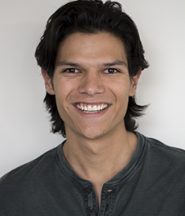An Overview
Major: Geosciences with Geophysics emphasis
Academic Affiliation: University of Arizona
Biography
Born and raised in southeast Arizona, Enrique’s familiarity with the Basin and Range Province became useful as he turned to study geology. He is ultimately interested in using physics to describe and understand Earth’s natural processes. These interests include large-scale structural geology, tectonics, and other hazard-related phenomena. This summer he worked with the NOAA Earth Systems Laboratory to study soil moisture observations from the Russian River basin, northern CA. His work will contribute to a better understanding of using soil moisture measurements to simulate streamflow and runoff values. This information is key in predicting flood events that commonly affect the area.
Abstract
2015- Spatial and Temporal Analysis of Soil Moisture Observations from the Russian River Basin
Statistical analyses have been used to study the temporal and spatial variability of soil moisture in the Russian River watershed. This observed variability has been compared to soil moisture variability simulated using the National Weather Service (NWS) Hydro Lab Research Distributed Hydrological Model (HL-RDHM). Soil moisture observation data for 2011 were obtained from the National Oceanic and Atmospheric Administration (NOAA) Hydrometeorology Testbed (HMT). These data were collected at seven soil moisture observing stations in the Russian River Basin. The model was run using a-priori parameter estimates and atmospheric forcing grids supplied by the NOAA Office of Hydrological Development (OHD) and the California Nevada River Forecast Center (CNRFC). The difference was taken between the HL-RDHM simulations and the observed data for use in the last part of the analysis.
The temporal variability of soil moisture in the basin was analyzed using the temporal autocorrelation functions calculated for each of the seven HMT observing stations during the study period. The spatial soil moisture variability was examined using correlation coefficients calculated for each possible station data pair in the network. Results from these two procedures indicate that coherent spatial and temporal features of the soil moisture field in the Russian River basin can be inferred from HMT soil moisture observations. The third part of the analysis involved the construction of a covariance matrix from the spatial and temporal differences between the simulated and observed data. A positive definite test on this matrix revealed that it is possible to minimize the difference between the HL-RDHM simulations and the corresponding soil moisture observations from the HMT network. These analyses can be used to help determine whether or not soil moisture observations can be assimilated into the HL-RDHM, and thereby improve the quality of its soil moisture and streamflow simulations.
2016- Earthquake Focal Mechanisms from the HOBITSS Ocean Bottom Seismology Experiment, Hikurangi Subduction Zone, New Zealand
Subduction thrust systems are important to understand because they generate the world’s largest, most devastating tsunamis. The Hikurangi subduction zone, with the trench just offshore of Gisborne, North Island, New Zealand, has been the site of episodic slow slip events that have major implications for seismic hazard assessment models in New Zealand (Wallace et al., 2016). In an effort to better define the faulting parameters at the plate interface and in the overriding plate, we used first arrival polarity data to determine seismic focal mechanisms for subduction zone earthquakes recorded during the Hikurangi Ocean Bottom Investigation of Tremor and Slow Slip (HOBITSS) project. A better understanding of the relationship between slow slip events and earthquake source parameters is needed to determine the likelihood of damaging earthquakes and tsunamis along the Hikurangi margin.
The HOBITSS project included the deployment of 35 ocean bottom seismometers and seafloor pressure gauges offshore of Gisborne. The addition of ocean bottom seismometers to New Zealand’s preexisting land seismic network, GeoNet, provides a new opportunity to study offshore earthquakes near their source. The GeoNet seismic catalog was used to identify events larger than M_w2.9 that occurred near the coast of Gisborne between May of 2014 and June of 2015. Specific earthquakes were chosen to correspond with the dates and locations of the HOBITSS instrumentation deployment so that adequate azimuthal station coverage was guaranteed for each solution. Data were used from both the GeoNet land network and the HOBITSS ocean bottom seismic network to relocate the events and to determine their focal mechanisms.
Resolvable patterns exist in our lower-hemisphere plots that help to define the geometry of faulting during each of our selected earthquakes. However, when we compare the results of our event relocations to New Zealand’s national seismic catalogue, we see notable differences in the depth determinations and epicentral locations. This is likely an artifact of several things. First, the locations of offshore events made by GeoNet may have increased uncertainty since the events are outside of their network. Second, our locations may lack the desired precision because of the velocity model that we used. GeoNet uses velocity models that have been developed to represent New Zealand at the regional scale, whereas the iasp91 model that we used describes the global velocity structure of the Earth. Although many of our relocations might be improvements to GeoNet’s offshore location values, further analysis will be done before any faulting parameters are drawn from our results. To better constrain the event-to-station travel time information needed to develop accurate focal mechanisms a more detailed regional velocity model will be implemented.
Posters
Spatial and Temporal Analysis of Soil Moisture Observations from the Russian River Basin

